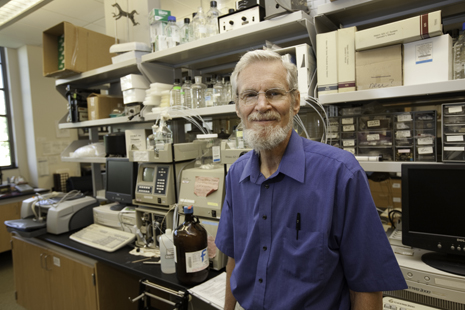
FAYETTEVILLE, Ark. – The University of Arkansas Center for Protein Structure and Function will receive more than $5.4 million over the next five years from the National Institutes of Health to continue the biomedical research it has established during the last decade.
The new funds will help expand the five already established core facilities within the center that support biomedical research. The money also will provide start-up funds to scientists with innovative ideas for new research projects.
“These grants will allow researchers to get some experimental evidence for their ideas so that they can write a major grant proposal,” said Frank Millett, Distinguished Professor of chemistry and biochemistry and director of the center. “You have to have significant preliminary results to get funding from NIH these days.”
Center projects emphasize developing a detailed understanding of the structure and function of proteins that could lead to improved treatments of human disease. Center scientists study proteins involved in cancer, heart disease, osteoporosis, the flu and other diseases and conditions.
The researchers examining these proteins use five core facilities to do their work. These include the nuclear magnetic resonance spectroscopy facility directed by James Hinton; the X-ray crystallography facility headed by Joshua Sakon; the mass spectrometry facility headed by Jackson Lay and Alan Tackett; the chemical synthesis facility headed by Robert Gawley; and the large-scale protein production facility directed by Ralph Henry. Scientists often use many or all of these facilities as they progress through different stages of a research project.
“These facilities have helped everyone involved in biomedical research on campus become competitive in getting research grants,” Millett said. Researchers in the center have brought in more than $60 million in grant support since it was founded in 2000.
In addition to building the core facilities, the university has hired 12 new tenure-track faculty members since 2000, in chemistry and biochemistry and in biological sciences as well as at the University of Arkansas for Medical Sciences. The university provided substantial start-up funds for these faculty members, which helped the center succeed and get continued funding.
“The reviewers noted very positively the university commitment here,” Millett said. “It was a major factor in getting all of these grants.”
Millett himself is no stranger to NIH funding: He has had continuous support from the organization for the past 36 years for his research into how energy is produced in animals at the molecular level. Defects in the process of energy production lead to degenerative processes, including aging, as well as problems linked to heart disease and other medical conditions.
The Center’s original senior investigators include: center director Millett, program coordinator Roger Koeppe, Bill Durham, James Hinton, Peter Pulay, Jackson Lay, Lothar Schafer and Charles Wilkins in chemistry and biochemistry. New senior investigators brought in as part of the NIH funding include Robert Gawley, Distinguished Professor of chemistry and biochemistry and Julie Stenken, professor and Twenty-First Century Chair in chemistry and biochemistry.
Mid-career investigators who started out as junior investigators include Denise Greathouse, T.K.S. Kumar, Matt McIntosh, Joshua Sakon and Wesley Stites in chemistry and biochemistry; Robyn Goforth, Ralph Henry, Michael Lehmann and Kathryn Curtin in biological sciences; and Paul Grover Miller, Kevin D. Raney and Alan Tackett in biochemistry and molecular biology at the University of Arkansas for Medical Sciences. These scientists “graduated” and got their own major research funding after receiving support from the center.
Current junior investigators include Paul Adams, Colin Heyes, Daniel Lessner and Nan Zheng in chemistry and biochemistry and Yu-Chun Du in biological sciences. All junior investigators have reduced teaching loads and can devote at least half of their time to research.
“To get faculty who are competitive for national grants, you need to be able to give them support for the first few years,” Millett said. The NIH funding for major instrumentation and the university commitment to start-up funds for laboratories created an environment where these junior researchers and the entire center could succeed, he said.
The grant is funded by the Centers of Biomedical Research Excellence program of the National Center for Research Resources, a part of the National Institutes of Health.
Topics
Contacts
Frank Millett, Distinguished Professor, chemistry and biochemistr
J. William Fulbright College of Arts and Sciences
479-575-4999, millett@uark.edu
Melissa Blouin, director of science and research communication
University Relations
479-575-3033,
blouin@uark.edu